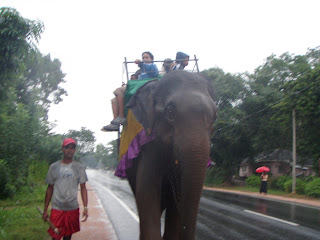We woke up on Tuesday morning with a glimmer of hope that the rain had
stopped but that was short lived as the heavens opened once more. We
decided to make a plan anyway and ventured out on an amazing tour which
was probably the favourite of the entire trip.

Our driver brought us to Hiriwadunna Nature Trail which was a little structure on the side of the road. We were not completely sure about what to expect but soon we saw this coming up the road towards us...
This was to be our first mode of transportation!
Here we are getting on...
all tucked in, ready to roll!
This would be a typical mode of transportation for people and goods in a rural Sri Lankanvillage.
We took a 15 to 20 minute ride through a village area, rice fields on either side of us... it was BEAUTIFUL!
The bullock cart brought us to our next mode of transportation...
...a paddle boat! The paddle boats are used by the villagers to fish. Only the villagers are allowed to fish in the lake and only using boats without motors.
All Aboard!
Here was our "captain". It was pouring by now!
We paddled across this beautiful lake. The plants you see are lotus flowers. You'll see a couple of uses of the water proof leaves further down.
Here was our parking spot while we ventured further inland....
We treked through muddy fields for 10 to 15 minutes. We were soaking wet but it was lots of fun. My flip flops kept sticking in the mud so after awhile I took them off.. all I kept thinking was "I really hope there are no snakes writhing around in here!"
We arrived at a village home were we were welcomed warmly.
The structures are built with mud and cow dung... the cow dung is to keep away the snakes! The roof is thatched coconut leaves.
cooking pots washed and drying
a basket of produce grown outside the hut
clay cooking and serving dishes
Here is the kitchen area of the home. It was a tiny room big enough for one person.
This is a look out above the hut. The farmer would spend the night up there keeping a watch for wild elephants that could destroy his crops. The would use fire crackers to scare the elephants away. The elephants could destroy a whole rice crop just by trampling it in search of food.
The hostess served us a herbal drink while we waited for lunch.
This is the niece of the farmer whose home we were visiting. She comes daily to cook for her uncle.
Remember the lotus leaves? They served as plates for our delicious meal!
It was a simple, authentically Sri Lankan meal cooked for us over an open fire. I remembered half way through eating to take a picture! We all ate with our fingers like real Sri Lankans.
After lunch the hostess showed us how to weave the coconut leaves for the thatched roofs. The roofing needs to be replaced every 4 months.
After a wonderful visit it was time to head back to the boat.
Here are elephant foot prints in a field we walked passed.
These are gourds from a tree. The villagers dry them out and use them to carry water.
another elephant look out
one more use of the lotus leaves...sailors hats!
From the boat we took out final mode of transport... the modern way to get around the village...
the tuk tuk!
We had a fabulous day in spite of the rain. If you are ever in Sri Lanka I would highly recommend the Hiriwadunna Nature Trail. Not only is it a great way to learn about Sri Lankan village culture but it also financially supports the villagers.


















 Our driver brought us to Hiriwadunna Nature Trail which was a little structure on the side of the road. We were not completely sure about what to expect but soon we saw this coming up the road towards us...
Our driver brought us to Hiriwadunna Nature Trail which was a little structure on the side of the road. We were not completely sure about what to expect but soon we saw this coming up the road towards us...
































